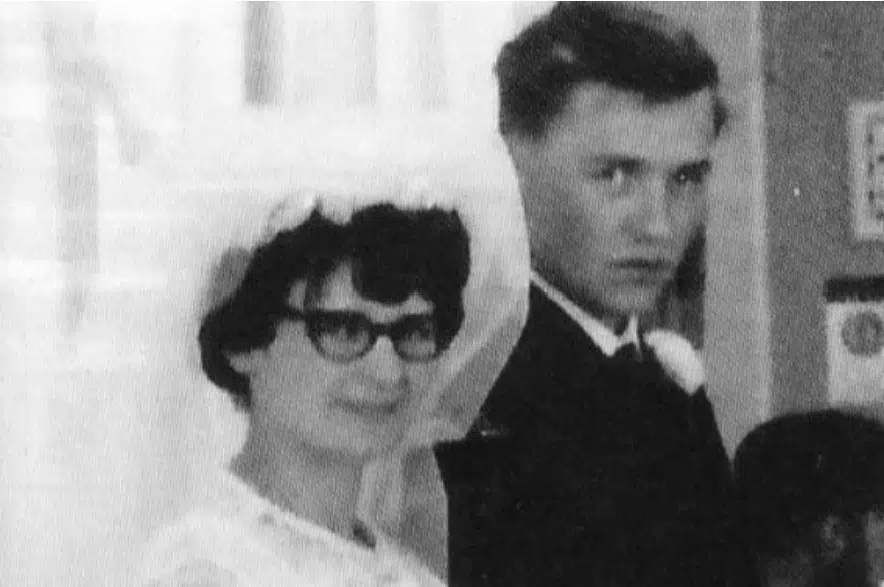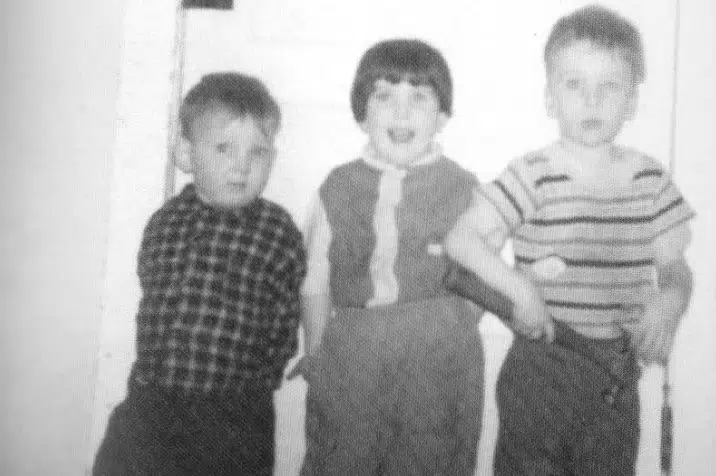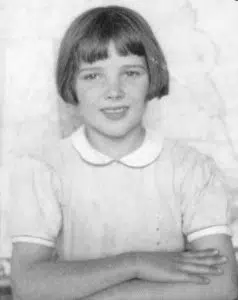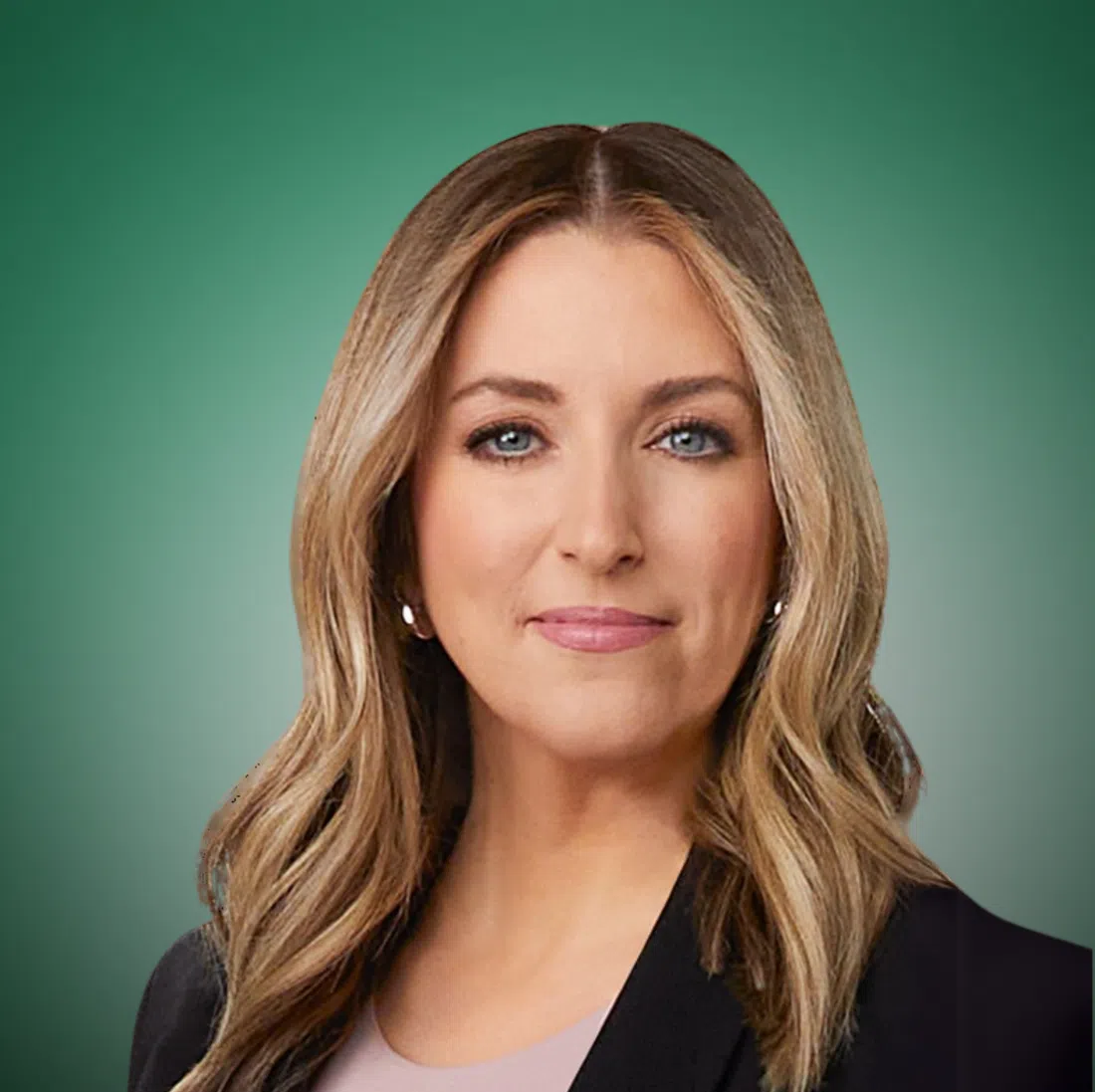Kathy Hill was a 19-year-old newlywed in the summer of 1967 when an unexpected knock on the door changed everything. Within hours, she was in a car heading toward the home she had left just a few weeks earlier, armed with few details about a gruesome murder that annihilated her family, leaving only one survivor.
Episode 3 explores Kathy’s journey back to Saskatchewan, the police hunt for the killer and the funeral for nine members of the Peterson family.
The Shell Lake Massacre podcast is a special presentation by Rawlco Radio. The six-part series hosted and produced by Brittany Caffet airs Tuesdays at 1:30 p.m. on 650 CKOM and 980 CJME. Weekly episodes are available for download on Apple Podcasts and Spotify.
Content warning: This episode contains depictions of violence and other content that may be disturbing. Listener discretion is advised.
Listen to episode 3: The Last of the Petersons
Listen to episode 2: The Night of Fear
Listen to episode 1: The Petersons
Transcript of Episode 3: The Last of the Petersons
Editor’s note: Colin Peterson died 19 days before his third birthday. He is referred to as three years old in the podcast.
Disclaimer: Most of the following transcription is AI generated, and errors may have occurred.
Kathy Hill hugged her family goodbye for the last time on July 9, 1967, just two days after her wedding. She set off with her new husband, Lee, to start a life together in Chetwynd, B.C., a logging community in the northeastern part of the province.
They had found a place to rent and were starting to settle into their new routine. They didn’t have a phone in their new home and there was no phone at the Peterson farm, so Kathy wasn’t able to call her family after she left Saskatchewan. She did, however, send mail. She remembers sending a birthday card to her dad, Jim, on July 16, and to her mom, Evelyn, on July 23. Jim had turned 47 and Evelyn 42.
Early on Aug. 16, 1967, there was a knock at the door of Kathy’s new home. Lee’s aunt and his brother, Ken, stood in the doorway… and they came bearing the most grim news imaginable.
[KATHY: “Lee’s mom and dad had phoned up to her sister. His mom’s sister lived just north of Hudson Hope and she got a phone call so she came down to tell us.”]
Lee’s aunt told Kathy that her parents and siblings had been shot to death in their home. It had taken a full day for the news of what had happened to the Petersons to make it to Kathy, by no fault of anyone in particular. The utter chaos and lack of phones in the area had made it challenging for anyone to get in contact with her.
Word hadn’t yet made it to them that one child had survived. Kathy hurriedly packed her things, disbelief swirling in her mind along with memories of her family. She thought of her hard-working, loving dad, Jim, and her quiet, gentle mom, Evelyn. She thought of Jean, Mary, Dorothy, Pearl, William, Phyllis, Colin and Larry. Her family was gone.
Kathy and Lee packed their things into a vehicle, and with Lee’s brother Ken driving, they began their journey back home. As they drove, they kept the radio on constantly, hoping to learn more details about what had occurred. That’s how Kathy found out that one of her siblings was still alive.
[KATHY: “I just remember wanting to know who was left and nobody knew. We had no idea until we got back to Saskatchewan which one of the kids was left. We had the radio on in the car all the time, but we didn’t really hear anything more than that there was a mass murder and one survivor. That’s all we ever heard.”]
The drive to Shell Lake from Chetwynd took nearly 16 hours. It was a long, quiet drive with Kathy, Lee and Ken all lost in their own thoughts, hoping to hear more information through the radio, and praying that they would wake up from this living nightmare.
As they approached the home they had left just over a month before, they encountered numerous check stops that the Royal Canadian Mounted Police had set up along roadways. Police were stopping every single vehicle in the area and questioning the occupants.
When they finally made it back to Shell Lake, they immediately headed to Lee’s parents’ home. They were told that the surviving child was with Kathy’s aunt and uncle, so they made the short drive to the Helgeton farm.
That’s where Kathy learned that four-year-old Phyllis was the sole survivor of the Shell Lake Massacre. The reunion was a blur for Kathy.
Four-year-old Phyllis Peterson, centre, survived the brutal attack. Police discovered her in bed, nestled between the bloody bodies of her sisters, Jean and Pearl. Photo of siblings from left to right, Colin, Phyllis and William Peterson (Kathy Hill/Submitted)
[KATHY: “I don’t really remember that part. I just remember grabbing ahold of her and hanging on.”]
The RCMP investigation into the murders was still in the very beginning stages. No motive had been determined and there were concerns that the killer may return and try to harm the two girls, so an officer was assigned to guard the last two members of the Peterson family.
[KATHY: “Phyllis came with us back to Lee’s mom and dad’s house. And then the RCMP actually had somebody sit in the house with us. And I remember the poor guy that was left sitting in the house to protect us was the same age as I was. He was just 19, 20 years old was all he was.”]
The magnitude of this crime completely shook the community of Shell Lake and everyone in it. Kathy was in a state of disbelief — going through the motions and doing what needed to be done in the moment, but unable to fully grasp the immensity of what was happening.
[KATHY: “It doesn’t sink in. I know I had the minister come and try and tell me that he had seen them and they all looked so peaceful. And it still didn’t … I think I was numb. I didn’t really think anything.”]
As the RCMP investigation progressed, the Mounties struggled to determine a motive. They questioned dozens of people in the Shell Lake area about Jim Peterson’s past, but there didn’t seem to be a soul who would have had a reason to hold a grudge against him. Kathy was interviewed by the police numerous times in the days that followed.
[KATHY: “They’d ask, ‘Who would be mad at your dad?’ and those kinds of things. Well, I had no idea. And I know that a lot of the neighbours were interviewed and everything, but there was no rhyme or reason to it. There was nothing.”]
Many homes in the area didn’t have phones and some didn’t even have televisions yet, but news of what had happened to the Petersons still managed to get out. News of the killings and the search for the killer was being broadcast far and wide, and the story spread like wildfire by word of mouth.
[KATHY: “Everything was on the radio and everybody had a radio on. And of course the telephone office was in Shell Lake, and once Wildrew (Lang) got down there and phoned for the RCMP, the telephone operator knew what was going on and she pretty much let everybody know.”]
With word spreading so quickly around the community and across the entire country with very few details available from the police, rumours began to spread right alongside the news of what had happened to the Petersons.
There was speculation that the death of the family was the result of a murder-suicide, some claimed the killer had to have been a jilted boyfriend of one of the elder Peterson daughters, and there were multiple reports in the first few days of the investigation that a suspect had been arrested, which police were quick to deny.
Kathy had achieved an instant, and very much unwanted, celebrity status because of her close proximity to this crime. Her face and the face of her four-year-old sister were splashed across the front page of papers across the entire country. Reporters followed her everywhere she went, hoping to get a headline-making quote.
[KATHY: “It seemed like every time we’d come back to Lee’s mother’s from wherever we were, there’d be a reporter standing there at the door trying to grab us and wanting answers and … I don’t know how many times I was interviewed, and none of what I actually said made it into the papers. They put their own spin on everything.” ]
Setting aside the rumours swirling around, the truth of what had happened within the Peterson home was horrific and left everyone in the area in a state of intense fear.
Up until this point, people in Shell Lake had felt safe in their homes. The brutality of the massacre had completely robbed the community of any sense of security. The wide-open prairies surrounding homes now left residents feeling exposed and vulnerable. The forests that had once felt like a secure haven suddenly seemed dark and foreboding. Nowhere, and no one, felt safe.
[KATHY: “Everybody was terrified. And I mean up until that point nobody even locked their door. And all of a sudden everybody was locking their door and they were sitting up with a gun in their hand.”]
Days went by and still no suspect had been arrested. Police worked diligently to recover as much evidence from the Peterson home as possible. Bullets had been cut from various sections of the blood-splattered walls. Pieces of linoleum, stained deep red, were also cut out and taken into evidence.
Once the house had been processed for evidence by the police, the home that had once been full of life was abandoned. Photos of the scene from old newspaper clippings collected over the years by Marjorie Simonar, neighbour to the Petersons, show haunting reminders of the family who had once called this crime scene home.
Jim’s medals from his time in the war sat on the dresser in the bedroom, feet away from the window that Evelyn had climbed out of with the baby in an attempt to escape. In the bedroom just off the living room where the children had been killed, pictures cut from magazines covered the rose-coloured walls: Mick Jagger. The Animals. The cast of the TV show Bonanza. They were a stark reminder of who these victims had been. They were just kids. They had been just like any other children in the area at the time … and now, because of a senseless violent act, they were dead.
The blood of the Petersons covered the beds, walls, floors, ceiling … it seemed as though no surface in the home had escaped the massacre unscathed. Family members went into the home to remove as much of it as they could.
[KATHY: “Lee’s dad and my uncles, and I think my aunts too, they went in and cleaned everything up. They took all the bedding and everything out and burned it, and basically cleaned the house up. (They) tore strips off the floor and walls and … so when I went in all I saw was fingerprint dust and that sort of thing in there. Everything else was gone.”]
Kathy was tasked with returning to her family’s home to retrieve any belongings she wanted to keep. Any items she chose to leave behind would be sold in an auction sale in the months to come.
It seemed like a nearly insurmountable task, but Kathy was able to muster the strength to drive down the driveway toward the Peterson farm, walk up to the front door and turn the knob. She stood looking into the home of her youth — but it didn’t feel like home anymore.
[KATHY: “I was supposed to take things out. Dad had an old gramophone that Grandma had given him. And I decided, ‘No, I’m not leaving that to go in a sale.’ But it’s really hard to take that stuff out, because I’m taking things away from my mom and dad. And the TV, I decided I was going to take that so Phyllis had a TV to watch. Otherwise I don’t know if I’d even have done that. It wasn’t easy because I had to go in the house and find clothes for her. And I finally gave up and just went and bought clothes. And a lot of the things there, I mean yeah there was keepsakes and what have you that I did take, but it was really hard to take anything out.”]
The reality that Jim, Evelyn and the majority of their children were dead was difficult to accept for every person who was close to the family. All of Kathy’s grandparents were still alive at the time. On the day of the massacre, the police had made the decision to bring Frederick and Martha Peterson as well as Norman and Martha Findlayson to the hospital in Shellbrook before telling them what had happened. There were concerns that one of them may have a heart attack or some other medical event after hearing the shocking news. Frederick Peterson was a stoic man, but the loss of his only son was incredibly hard on him.
Kathy Hill was the eldest of nine siblings in the Peterson family. At 19, she achieved an instant and unwanted celebrity status because of her proximity to this crime. (Kathy Hill/Submitted)
[KATHY: “And as my grandfather said to me at one point, he said, ‘And all of the boys. The end of an era.’ And to them, at that time, it was important to have somebody to carry on the name.”]
With no boys left to carry on the family name, Kathy and Phyllis were the very last of the Petersons.
On Aug. 19, 1967, four days after their murder, nine members of the Peterson family were laid to rest in the Shell Lake cemetery. It’s estimated that well over 1,500 people attended the service.
[KATHY: “We had the funeral right at the cemetery, because there was nowhere else that was going to hold everybody. I don’t know how many people were there. I have no idea. But the whole town was. And all the friends and relatives and what have you … that’s a lot of people. They had benches set up for us to sit on, like my aunts and uncles and Lee and I, and I think Lee’s mom and dad. But everybody else was just standing. I don’t know that I even took any of it in. I remember sitting there, but other than that, nothing. I know we got one of the neighbour women to stay with Phyllis and some of the younger kids. Because I said, ‘She doesn’t need to be there.’ “]
Gale Davidson, who grew up right across the highway from the Petersons, remembers the day of the funeral like it was yesterday.
[GALE: “I remember at the funeral. Kathy is a pretty tough woman. She didn’t cry. She was just so staunch … Well, obviously Phyllis didn’t come to the funeral. It was just Kathy. But she didn’t cry and she just looked so … totally in shock. But you have all of these coffins, like a mass of coffins. It was just an overwhelming scene.”]
The Royal Canadian Legion provided a guard of honour and Jim Peterson’s casket was draped with a Canadian flag. Members of the Legion saluted Jim’s coffin as a bugler sounded The Last Post.
Eight caskets sat on timbers above one large grave, neatly arranged in two rows. It had been decided that baby Larry would be laid to rest in the arms of his mother, Evelyn, the same way they had died just days earlier. A bouquet of roses sat atop the casket containing the bodies of Evelyn and Larry, and a single red rose was laid atop the casket of each child. One by one, the caskets were lowered into the grave and then covered with dirt.
Jim.
Evelyn and Larry.
Seventeen-year-old Jean.
Thirteen-year-old Mary.
Eleven-year-old Dorothy.
Nine-year-old Pearl.
Five-year-old William.
Three-year-old Colin.
Reporter Ron Shorvoyce was at the funeral, and he vividly remembers how he felt after witnessing the burial of nine members of the Peterson family.
[SHORVOYCE: “It was really something to attend. And you know, I was taking it pretty good up until then. But on the way home … my home is Wakaw, so I drove back home right after the service at the cemetery … after filing a report of course. Then it kind of hit me. And it still does.”]
All but two members of Jim Peterson’s family were dead and buried, and their killer was still free. But not for long.
Hours after the funeral, another life-changing knock on the door came, this time at the home of Kathy’s mother- and father-in-law. It was the RCMP stopping in to let Kathy know that the person who was believed to have murdered nearly her entire family in cold blood was in police custody. Victor Ernest Hoffman was officially under arrest.
Credits
The Shell Lake Massacre is a Rawlco Radio production. The show was researched, written, produced and hosted by Brittany Caffet. Supervising producers Sarah Mills and Murray Wood. Story consultant Craig Silliphant. Production support by Dallas Doell. Graphic design by Jennifer Losie. Special thanks to Erin McNutt and John Gormley.













